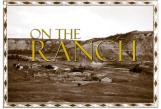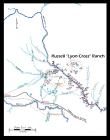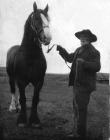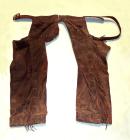1
1. On the RANCH3
In the late 19th century, ranchers could allow their animal herds to roam and graze on the natural prairie grass covering vast areas. Fences were not necessary to contain the animals, as ranchers branded their herds with identifiable markings or brands. When needed, ranchers on horseback would round up their herds for branding and dipping or to bring them back from their summer pasture to shelter them for the winter.When the early settlers started to arrive into this area in the 1900's; the freedoms for many of the ranchers were restricted as their grazing land was gradually measured into townships and sections for the new homesteads and soon contained by fences.
Some ranchers adapted to the changes and some moved their ranches downriver east of the Drumheller town site.
5
1. The Pope Lease2. Russell - Lyon Cross Ranch
3. Greentree
4. Wallace
5. Slade
6. Calhoun
7. Marriott
8. Newman's Lone Star
9. Miller
10. Black
11. Pyle
12. Montgomery
13. Taylor
14. Peake
15. Kelly
16. Neely
17. Brereton
18. The Trefoil
19. Gigot
20. McNeil & Dyment
21. Finnegan
22. Powlett
23. Wright
24. Caldwell
25. White
26. Gow
27. Hutton
28. Fieldholm
29. Fields
30. Douglass
31. Bray
32. Emerson
33. Flint
34. Bolt
35. Gregory
36. Ware
37. Macleary
38. Eide's PK
39. The Circle
40. The Mexico
41. Owens
42. Quail
43. Clark
44. Davies
45. de Blacquere
46. Graham
47. Bray
48. The Two Bar
49. Auburn
50. Hall
51. Swanson & McGilvery
52. Kenny
53. J. Wishart
54. Hope Johnston
55. D. Wishart
56. Cook
57. Martin
58. Bushman
59. D. Vigar
60. F. Vigar
61. Till
62. Paquette
63. Langlet
64. Morton
65. Biggs
66. Thumb Hill
7
Author: Dave Russell (one of James Russell's grandsons)Excerpt from an essay "Change in Land Use in the Drumheller Area," 1972
"In 1896, James Russell and John Neill entered the Red Deer River Valley at about the present location of Rosedale [Alberta]. They had travelled from Calgary along the south bank of the Rosebud Creek in search of ranching land.
They went west, upstream on horse back to the present location of Nacmine where they discovered that the grassland from the flat land above the valley to the south extended unbroken down to the river. James Russell decided to make this the headquarters for the Lyon Cross Ranch and then returned to Calgary. John Neill settled on the other side of the river ten miles north along the Red Deer [River].
The land they had come to was grass covered and had never known cultivation. As near as can be determined the grass was all of the type known as prairie wool. The land in the area…ranges in quality from badlands, which are devoid of any growth to rich deep gumbo soil, which can produce most cereal crops in bumper crop proportions.
James Russell had worked in Calgary as a steam engineer for the City of Calgary since 1891 and had in the meantime built up a herd of cattle. These cattle were purchased in Eastern Canada, shipped by rail to Calgary and pastured in about the location of the present Southern Alberta Institute of Technology. In 1897, these cattle and Mr. Russell's family were moved to the ranch on the Red Deer [River]."
9
Author: Mary (Galloway-Beckwith) Russell, wife of James RussellExcerpts from a letter written to the Calgary Daily Herald Newspaper
January 25, 1936, Drumheller, Alberta
"…he decided to go ranching in 1896 he purchased 100 head of female Shorthorns [cattle] from Ontario. In 1897, he came to the Red Deer Valley & settled where the Nacmine Village is to-day. Having a grazing lease of 10,000 acres lying north of the Red Deer River.
This he held until Dec. 1907 when the land had been surveyed & subdivided for Homestead purposes. Mr. Russell shipped many herds of cattle each season driving them in winter to Strathmore [Alberta] or Gleichen [Alberta]. Mr. Russell had many experiences crossing the Red Deer River, sometimes team & wagon & sometimes saddle horse; but if he thought it was not fit to cross he would advise people to stay on the one side.
He built the first ferry in the neighbourhood and many old timers to-day will remember crossing at the Russell ferry.
In 1906 the beginning of the hard winter 20 Registered Bulls were put in the shed & fed & watered every day; but in the spring there were only 12 living, that same winter there was a loss around 600 head of cattle."
11
Author: Dave Russell (one of James Russell's grandsons)Excerpts from an essay "Change in Land Use in the Drumheller Area," 1972
"In the winter of 1906, the weather hit with a vengeance and left much of the accumulated livestock dead or in bad shape by spring. Mr. Russell had brought twenty bulls from Calgary and fed them prairie hay in a barn all winter. By spring only eight of the bulls had survived the cold of winter.
John Neill and James Russell worked together with a number of the newer ranchers in the area during the summer to combat the losses due to mange in the cattle. They constructed a dip tank which had a circulating heated mixture of sulphur and lime deep enough that the cattle had to swim to get out the other side. It was reported to be an effective cure and the strength of the mixture was attested to by occasional skin burns to the helping ranch hands."
14
Plowing with a Four Horse Team at 'Lyon Cross Ranch'1920
Drumheller Region, Alberta
 Credits:
Credits:Russell Family Collection






